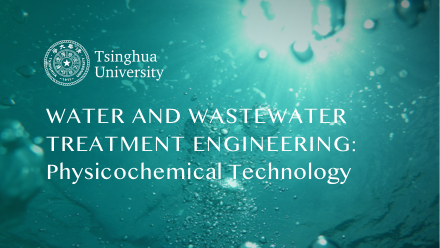
当前课程知识点:Water and Wastewater Treatment Engineering: Physicochemical Technology > Chapter 2 Sedimentation and clarification > 2-9 Clarification pool > 2-9 Clarification pool
返回《Water and Wastewater Treatment Engineering: Physicochemical Technology》慕课在线视频课程列表
返回《Water and Wastewater Treatment Engineering: Physicochemical Technology》慕课在线视频列表
同学们好,在这一讲,我们将介绍沉淀与澄清这一章的最后一节,澄清池
在前面,我们讨论的都是沉淀池
在沉淀池中,悬浮颗粒沉淀到池底,就算完成了沉淀过程
沉淀泥渣随后排出池外,不再循环利用
而实际上,这个沉淀的泥渣具有很高的接触絮凝活性
在水处理中是可以把它再利用起来的
如何把这些沉淀的泥渣再循环利用起来呢?这就是澄清池的功能
在澄清池中,我们可以通过水力或者机械的手段
将沉淀到池底的污泥再提升起来,使它们处于悬浮状态
当原水与悬浮泥渣接触时
原水中的脱稳胶体和细小的悬浮物就会被泥渣吸附或截留
使水得到澄清,这就是澄清池的工作过程
澄清池常用于给水处理,也可用于废水处理
澄清池中悬浮泥渣层通常是在澄清池开始运转时
在原水中投加较多的混凝剂,经过一定时间运转后,逐步形成的
如果原水悬浮物浓度很低,我们有时可以人工投加粘土,来加速泥渣层的形成
澄清池中泥渣层浓度一般比较高,在3-10g/L左右
可以通过适当排泥来控制泥渣浓度
澄清池的形式有多种,一般可以按照工作原理分成两大类
第一类是泥渣悬浮型澄清池
它的主要工作特征是,泥渣通过水力作用悬浮在澄清池中
当原水由下而上通过泥渣层时
原水中的杂质就会与高浓度的泥渣进行接触、絮凝,最后被拦截下来
这种作用相当于过滤作用,因此,又称为泥渣过滤型澄清池
这种澄清池对细小的杂质具有很好的拦截作用
但有时泥渣会随水流被冲出去
泥渣悬浮型澄清池常用的有脉冲澄清池和悬浮澄清池
第二类是泥渣循环型澄清池
泥渣通过水力或机械作用在澄清池内循环流动,原水中细小的杂质与泥渣接触
被吸附、絮凝后再通过沉淀进行固液分离,从而获得处理水
泥渣循环型澄清池有时也称为分离型澄清池
这类澄清池常用的有机械搅拌澄清池和水力循环澄清池
下面我们对这两大类澄清池的代表性构筑物进行介绍
首先是脉冲澄清池,我们先来看看脉冲澄清池的结构示意
从这个图我们可以看到,脉冲澄清池通常是成组运行,在中间设有进水室
原水从进水室进入到澄清池底部,通过底部的穿孔配水管
均匀配入到澄清池中
穿孔配水管的结构示意如这个图所示
我们可以看到,在穿孔配水管的上部,设置了稳流板
原水通过穿孔配水管进入后,通过稳流板的阻挡作用
可以均匀地分布到悬浮泥渣层底部
在通过悬浮泥渣层的过程中,原水中细小的杂质被拦截去除
这样就得到的澄清水,然后通过上部的集水槽收集后排出
脉冲澄清池的主要特征是脉冲进水,这是如何实现的呢?
脉冲进水通常是靠脉冲发生器来进行控制
脉冲发生器有多种形式,一般可以采用真空泵脉冲发生器来达到脉冲进水的目的
那么,真空泵脉冲发生器是如何工作的呢?
我们来看看,在进水室的上部设置了一个真空泵
真空泵对进水室抽吸,造成进水室形成真空
从而使原水进入到进水室,这个过程为充水过程
当水位到达进水室最高水位时,真空泵的进气阀自动开启
使进水室与大气相通,进水室的真空得到破坏
这时进水室内水位迅速下降,向澄清池放水,此过程为放水过程
当水位下降到进水室最低水位时,真空泵的进气阀又自动关闭
真空泵再次启动,造成进水室内的真空
进水室又开始进水,水位又开始上升,如此反复,形成脉冲进水
冲水时间一般为25-30s,放水时间一般为6-10s,总的时间称为脉冲周期
这种脉冲进水方式会有什么好处呢?
脉冲进水使悬浮层发生周期性的收缩和膨胀
有利于原水中的杂质颗粒与悬浮层泥渣接触
悬浮泥渣层在放水期间可能会被水流冲散
但在充水期间会自身进行调节,浓度趋于均匀
由于脉冲作用的优点,澄清池单池面积可以做得比较大
配水也比较均匀,造价比较低,工作也比较稳定
但冲水和放水的脉冲周期不易调整,这是它的不足
第二,我们介绍机械搅拌澄清池
大家可以看到,机械搅拌澄清池主要由第一絮凝室,第二絮凝室以及分离室构成
整个池体上部是圆筒形,下部是截头圆锥形
中间有两个圆筒,在最里面圆筒下部连接了一个带裙板的圆锥形筒
在这个部位形成环形三角配水槽
在第一絮凝室和第二絮凝室之间,安装有搅拌设备,由提升叶轮和搅拌浆组成
原水先进入到环形三角配水槽中
沿三角配水槽与圆锥形筒之间的缝隙均匀地流入到第一絮凝室中
混凝剂可以投加到三角配水槽或者第一絮凝室中
在搅拌设备搅拌下,原水与第一絮凝室中的泥渣充分接触
原水中细小的杂质被泥渣吸附絮凝
形成的絮凝体在搅拌设备叶轮的提升作用下,进入到第二絮凝室
进行进一步的絮凝,形成更大而结实的絮凝体
然后进入到分离室中进行固液分离
在分离室进行固液分离后的澄清水溢流进入设置在上部的辐射式集水槽
再经环形集水槽汇集后排出
而沉淀下来的泥渣,一部分通过裙板与锥形池壁的回流缝隙再进入到第一絮凝池
重新参加吸附絮凝
另一部分则通过污泥斗的收集后排出
在分离室中,我们还可以加设斜板斜管,来提高沉淀分离效率
大家可以看到,这是安装在分离室的中斜板
这是分离室的辐射式集水槽,这是环形集水槽,右边是第二絮凝池
我们可以通过两边的颜色对比,可以看到,处理后的水非常清澈
在机械搅拌澄清池中
泥渣的循环与流动是靠搅拌设备提升叶轮的开启度和搅拌桨的搅拌强度
以及回流缝隙的大小等来控制的
要达到良好的循环流动效果
通常需要把第一絮凝室、第二絮凝室和分离室的容积比控制在2:1:7
机械搅拌澄清池由于泥渣的快速循环
使得原水中细小的杂质,可以与泥渣进行吸附絮凝,从而使得去除率比较高
得到的澄清效果也比较好
通常停留时间比较短,一般在1.2-1.5小时,比平流式快
由此我们可以看到机械搅拌澄清池的高效性
机械搅拌澄清池的主要优点是,处理效果好、工作稳定、适应性强
主要适用于大、中水处理厂,但它的缺点是需要对机械设备进行定期维修
关于第3章沉淀与澄清的内容就全部介绍完了,谢谢
-0-2 Water treatment process
-0-3 Wastewater treatment process
--0-3 Wastewater treatment process
-Chap 0 Homeworks
-1-1 Introduction
-1-2 Properties of colloids
-1-3 Mechanisms and process of coagulation and flocculation
--1-3 Mechanisms of coagulation and flocculation
-1-4 Coagulant and coagulant aids
-- 1-4 Coagulant and coagulant aids
-1-5 Kinetics of coagulation and flocculation
--1-5 Kinetics of coagulation and flocculation
-1-6 Factors affecting the coagulation performance
--1-6 Factors affecting the coagulation performance
-1-7 Facilities for coagulation and flocculation
--1-7 Facilities for coagulation and flocculation
-Chapter 1 Homeworks
-2-1 Introduction
-2-2 Discrete particle settling
--2-2 Discrete particle settling
-2-3 Flocculent settling
-2-4 Zone settling
-2-5 Rectangular settling tank
--2-5 Rectangular settling tanks
-2-6 Process calculation of rectangular settling tanks
--2-6 Process calculation of rectangular settling tanks
-2-7 Vertical Flow (up-flow ) and radial flow settling tank
--2-7 Vertical Flow (up-flow ) and radial flow settling tank
-2-8 Plated sedimentation tank
--2-8 Plated sedimentation tank
-2-9 Clarification pool
-3D interactive demonstration for settling tanks
-Chapter 2 Homework (part 1)
-Chapter 2 Homework (part 2)
-3-1 Introduction
-3-2 Theoretical foundation of air floatation
--3-2 Theoretical foundation of air floatation
-3-3 Pressurized dissolved air flotation
--3-3 Pressurized dissolved air flotation
-Chapter 3 Homework
-4-1 Introduction
-4-2 Structure and process of conventional rapid filter
--4-2 Structure and process of conventional rapid filter
-4-3 Water head loss of filter
--4-3 Water head loss of filter
-4-4 Filtration method of filter
--4-4 Filtration method of filter
-4-5 Filter media
-4-6 Water distribution system
--4-6 Water distribution system
-4-7 Filter backwashing
-4-8 Siphon filter
-4-9 Gravity valveless filter
--4-9 Gravity valveless filter
-4-10 Movable hood filter
-3D interactive demonstration for filtration tanks
--Usage and description for 3-D demonstration
-Chapter 4 Homework
-5-1 Introduction
-5-2 Influence factors of disinfection
--5-2 Influence factors of disinfection
-5-3 Chlorine disinfection
-5-4 Chlorine dioxide disinfection
--5-4 Chlorine dioxide disinfection
-5-5 Ultraviolet disinfection
--5-5 Ultraviolet disinfection
-Chapter 5 Homework
-6-1 Ion-exchange resin
-6-2 Properties of ion-exchange reactions
--6-2 Properties of ion-exchange reactions
-6-3 Properties of cation exchange resin
--6-3 Properties of cation exchange resin
-6-4 Properties of anion exchange resin
--6-4 Properties of anion exchange resin
-6-5 Softening system using ion exchange
--6-5 Softening system using ion exchange
-6-6 Desalination system using ion exchange
--6-6 Desalination system using ion exchange
-6-7 Ion-exchange equipment
-6-8 Treatment of industrial wastewater by ion-exchange method
--6-8 Treatment of industrial wastewater by ion-exchange method
-Chapter 6 Homework
-7-1 Introduction
-7-2 Principle and characteristics of electrodialysis
--7-2 Principle and characteristics of electrodialysis
-7-3 Configuration of electrodialysis unit
--7-3 Configuration of electrodialysis unit
-7-4 Operating parameters for electrodialysis unit
--7-4 Operating parameters for electrodialysis unit
-7-5 Principle and process of reverse osmosis
--7-5 Principle and process of reverse osmosis
-7-6 Operating parameters for reverse osmosis
--7-6 Operating parameters for reverse osmosis
-7-7 Principles and characteristics of UF and MF
--7-7 Principles and characteristics of UF and MF
-7-8 Design of ultrafiltration and microfiltration process
--7-8 Design of ultrafiltration and microfiltration process
-Chapter 7 Homework
-8-1 Fundamental knowledge and classification
--8-1 Fundamental knowledge and classification
-8-2 Ozonation
-8-3 Photo-catalytic oxidation
--8-3 Photo-catalytic oxidation
-8-4 Supercritical water oxidation
--8-4 Supercritical water oxidation
-8-5 Electrolysis
-Chapter 8 Homework
-9-1 Introduction
-9-2 Adsorption equilibrium and adsorption isotherm
--9-2 Adsorption equilibrium and adsorption isotherm
-9-3 Adsorption breakthrough curve
--9-3 Adsorption breakthrough curve
-Chapter 9 Homework

